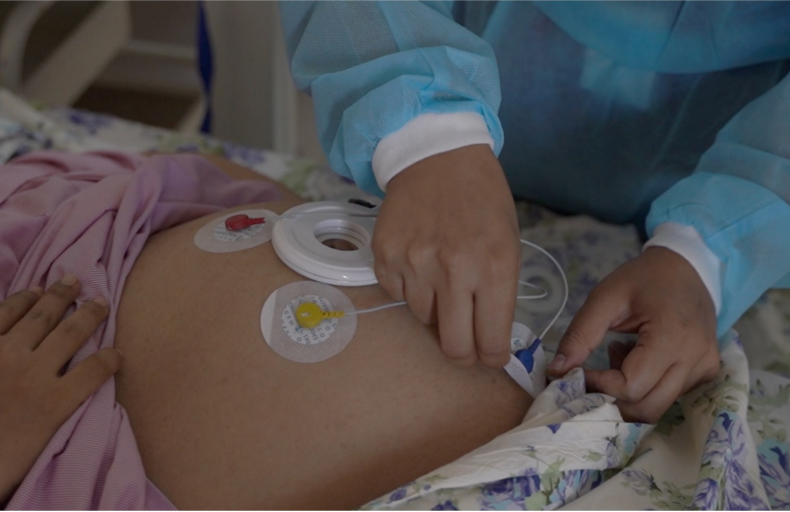
Fetal Heart Monitors, also known as Cardiotocography or CTG machine, Non-Stress Test or NST machines are used to monitor heart rate of babies. The main purpose of fetal heart rate monitoring during pregnancy especially during labour is to detect fetal distress. Most Fetal Heart Monitors available today use Ultrasound Doppler technology and measure & report Fetal Heart rate (FHR), Maternal Heart rate (MHR) and Uterine Contractions (UC). There are newer Fetal Heart Monitors coming up with better technology aimed at providing more accurate, timely data and alerts to caregivers while giving more comfort & mobility to the pregnant mother during labour. In this article we will cover 5 latest developments in fetal heart monitoring that we see today.
Why should Fetal Heart rate be monitored during Labour?
What is fetal distress?
Fetal distress usually indicates the baby is not getting enough oxygen. Without enough oxygen the stress of labour could threaten an infant’s health or even survival. Hence it is crucial to detect fetal distress at the earliest and ensure early delivery for the infant’s welfare.
Babies who experience fetal distress, such as having unusual heart rate or passing meuconium during labour, are at greater risk of complications after birth. Lack of oxygen during birth can lead to very serious complications for the baby, including a brain injury, cerebral palsy and even stillbirth.
Fetal distress is diagnosed by reading the baby’s heart rate. A slow heart rate, or unusual patterns in the heart rate, may signal fetal distress.
A baby’s heart rate during labour is expected to be between 110 – 160 beats per minute, but it may fluctuate above or below this rate for several reasons. Short bursts of acceleration of the baby’s heart rate or brief deceleration in the baby’s heart rate can be normal. If the heart rate is seen to be slower or accelerating unexpectedly – are not occurring at the rates they should be, or if they are too long, it could mean a number of things, such as the umbilical cord is compressed and blood flow to the baby has been slowed. Sometimes a simple intervention such as changing the mother’s position could release the pressure on the umbilical cord and improve the situation. If the fetal heart rate results indicate that your baby may be in danger, your physician may recommend an operative vaginal delivery (using forceps or a vacuum device) or a cesarean section.
Latest advances in Fetal Heart Monitoring
Fetal heart monitors are useful tools, and babies’ lives have been saved because this technology has alerted caregivers to problems. However, it is not only the fetal heart rate that decides it all. Sometimes other factors e.g. the mother’s health at the time affects the baby, so we need to take that into account.
Some advanced NST machines include other maternal health parameters such as NiBP, SpO2, Temperature, Respiration and ECG (almost replacing a 5-para monitor) as well as FHR, MHR and UC. However the doctor still needs to process all the data in their head and decide on further course of action.
This is where some of the upcoming Fetal Heart Monitors are making advances based on AI, analytics – essentially processing all relevant data comprehensively in place of a good doctor and raising timely alerts.
5 things to look for in newer Fetal Heart Monitors
- Wireless, beltless water-proof electrode patch for better mobility & freedom
Recent fetal heart monitoring systems such as Keyar from Janitri and Novii from GE Healthcare feature a wireless / beltless electrode patch and pod devices. Unlike the Doppler based tocography NST machines, where the mother has to be in bed connected to all the wires monitoring the hearts rates and contractions, wireless electrode patch device allows for the mother to mode around in the room and change her position even if lying down freely.
- One-time placement – No re-positioning requirement
In the older ultrasound doppler and transducer based CTG machines, often repositioning of transducers is required when the baby moved around, since the signal weakened. No such re-positioning of electrodes is required in the newer wireless devices. Fetal Heart monitoring devices like Keyar and Novii use EMG signals to track FHR, MHR and UC, which is strong enough no matter, how much fetal movement is there.
- More effective EMG signal rather than Ultrasound Doppler signal
In some cases such as when the BMI of the mother is high, reliable readings may not be obtained from Doppler based CTG machines, whereas the EMG signal based newer wireless devices acquire reliable tracings on even high BMI patients by monitoring electrical signals on the patient’s abdomen, which are not compromised by high BMI.
- Remote monitoring
Devices like Keyar from Janitri allow regular transmission and cloud storage of data. Hence this provides mapping trends over the labour and also mobile notifications/ alerts to the doctor even if they are away from the labour room in their OPD or Surgery.
- Cloud storage , integration with EMR and in-built analysed data
Fetal Heart Monitoring Devices like Keyar from Janitri allow cloud storage of data over a period of time along with several other maternal parameters and clinical data additionally entered by the care givers. This could be integrated with Electronics Medical Records of the patient for better analytics and clinical outcome. If proper data is recorded, it automatically helps calculate ROBSON Classification, BISHOP score or APGAR score etc.
Recent advance in Fetal Heart Monitoring systems definitely look promising from the point of view of increased patient comfort & safety and greater assistance to physicians and caregivers.
We offer Non Stress Test or NST machine on rent for Fetal Heart monitoring at Home. Contact us on +917019759765 or +918971223957 for any medical equipment or related spares & services.
https://in.linkedin.com/in/shanthi-mathur-ab07838
